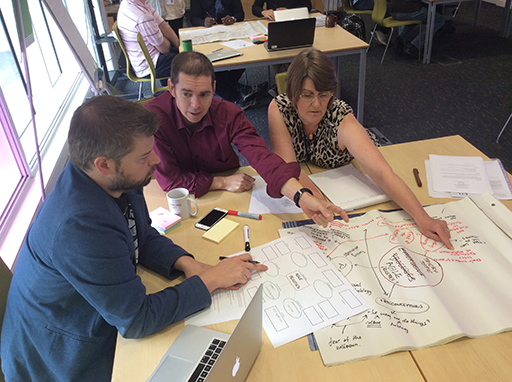4 Different ways of conducting the tricky topics process
As you learned from the tricky topics guide, the tricky topics process works best when teachers/practitioners can come together to discuss the problems that their students have, and are able to share their ideas about specific tricky topics.
There are many different ways of collaborating. You may already work with teachers collaboratively or have chance to work with other colleagues collaboratively. The tricky topics guide was specifically designed around face-to-face workshops in which teachers can brainstorm the topics without restriction, enabling ‘blue sky’ thinking. However, time is often short, as well as costly, and some teachers, such as distance learning tutors, are miles away from each other. So, it is now very common for us to conduct meetings and conferences online and it is also possible to conduct the collaborative tricky topics process online.
Here are a few tips for collaborative workshop as part of the tricky topics process. These tips are split into three sections as it is necessary to consider 1) the planning of the workshop, 2) the facilitation of the workshop on the day, and 3) the post-workshop activities which will ensure that the outcomes are followed through to develop interventions in order to improve teaching and learning.
1. Planning the workshop
As specified in the tricky topics guide, facilitation of a workshop is key and it is necessary to keep participants focused on the task, providing guidance about what is, or is not, a tricky topic, stumbling block or problem example. Therefore, all workshops should be manageable in size. It is recommended that no more than 20 teachers in groups of four or five for a face-to-face workshop, although a recent workshop in Africa was successfully conducted with 40 teachers. Fully online workshops should be smaller as facilitation and producing output can be more difficult (see below). However, it is possible to mix some online with face-to-face workshops as long as this is planned in advance.
Each group in a workshop will be expected to share their knowledge of problems with the aim of coming to a shared decision on what are tricky topics, stumbling blocks and problem examples. Therefore, the people invited to a tricky topics workshop should be able to work together in this way. Multiple teaching areas in one workshop is fine, so long as those working in each group can find some common ground, for example science teachers.
Resources required are minimal – they include paper, pens, highlighters and blank structure diagrams for a face-to-face workshop. Online workshops will require collaborative software which allows break-out rooms that can complete whiteboards and pre-prepared blank structure charts collaboratively. Pre-workshop activities such as carefully focused forums can be helpful to provide some focus for discussion, especially where workshops will only hold a small proportion of all teachers/tutors. The forums can enable many more teachers/tutors to feed into the discussion and give their examples of problems. However, forum discussions will need to be monitored and summarised before the workshop.
2. On the day
If recording is required, recording equipment will be needed for each group and the tables of a face-to-face workshop should be far enough apart so that the audio equipment does not interfere with each other. Only one facilitator is essential but more than one is helpful, especially with larger workshops.
Online facilitation is more difficult as individual groups require breakout rooms with separate facilitation and may not be recordable so the plenary must discuss outputs from each break-out room and must occur in the main room which can be recorded. A mixture of online and face-to-face is possible. For example an audio/video device with an additional online participant can be added to each face-to-face group relatively simply but this will require much forward planning.
The tricky topics identification stage of the process can be lengthy (up to 2 hours) even if pre-workshop forums are used, so adequate time must be allowed. Capturing the tricky topics into neat structures can be completed afterwards but these will need to be completed by knowledgeable participants rather than administration staff who do not know the terminology (as terminology is very important and can be easily confused).
Some form of plenary is vital for all workshops to ensure that there is consensus about how to move forward with interventions and evaluation.
3. Post-workshop activities
Whether the workshops are face-to-face, online or mixture of both, they will all have outputs which will require processing afterwards. Ideally the workshops should finish with neat tricky topics structures, solid plans for interventions and ideas for questions which will be used in order to evaluate success of that intervention.
However, most workshops will not reach this stage and a good plenary is necessary to pull the ideas together and plan for follow-on procedures. Even if the plenary is very good and the follow-on procedures to develop interventions and evaluations are fully decided and discussed, some after-workshop activities will be required to tidy up the tricky topic structures and manage those follow-on procedures.
As will be seen in the following weeks, the interventions will require careful design to ensure that they adequately overcome the stumbling blocks of the identified tricky topics. Similarly, quiz questions need to be carefully designed to ensure that the intervention is fully evaluated so that the teaching and learning of the tricky topics is improved.

